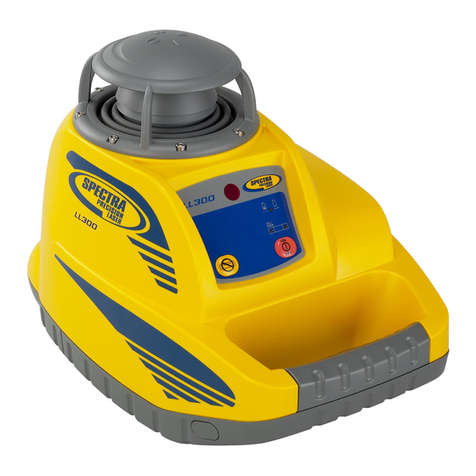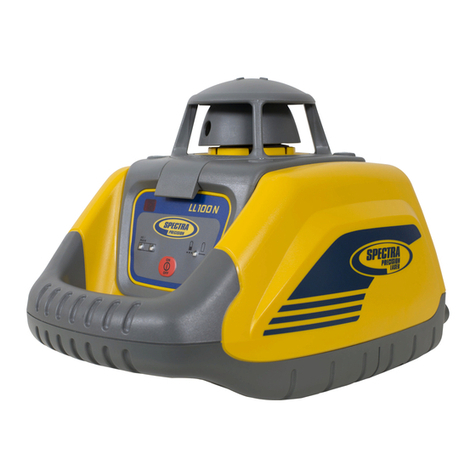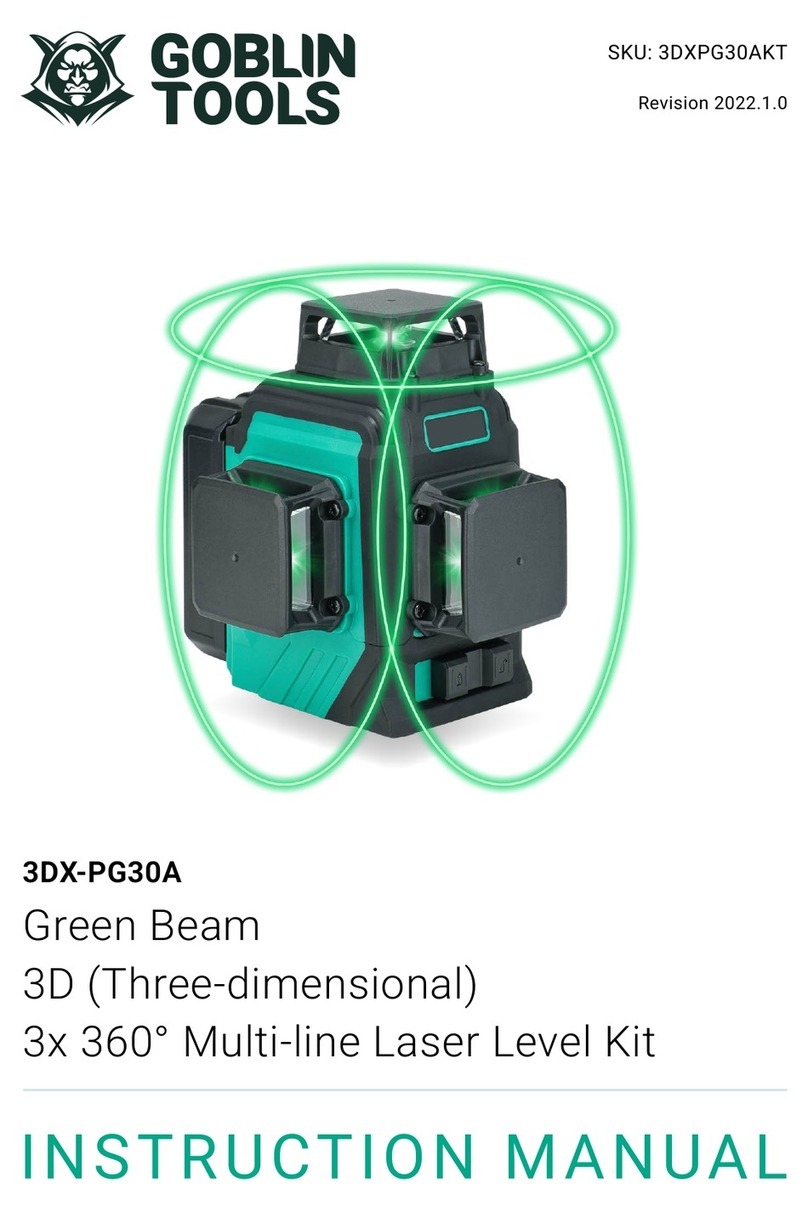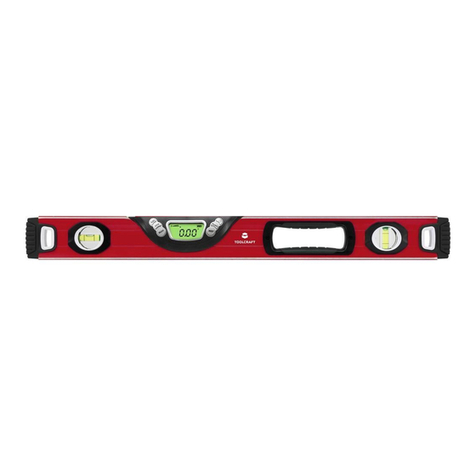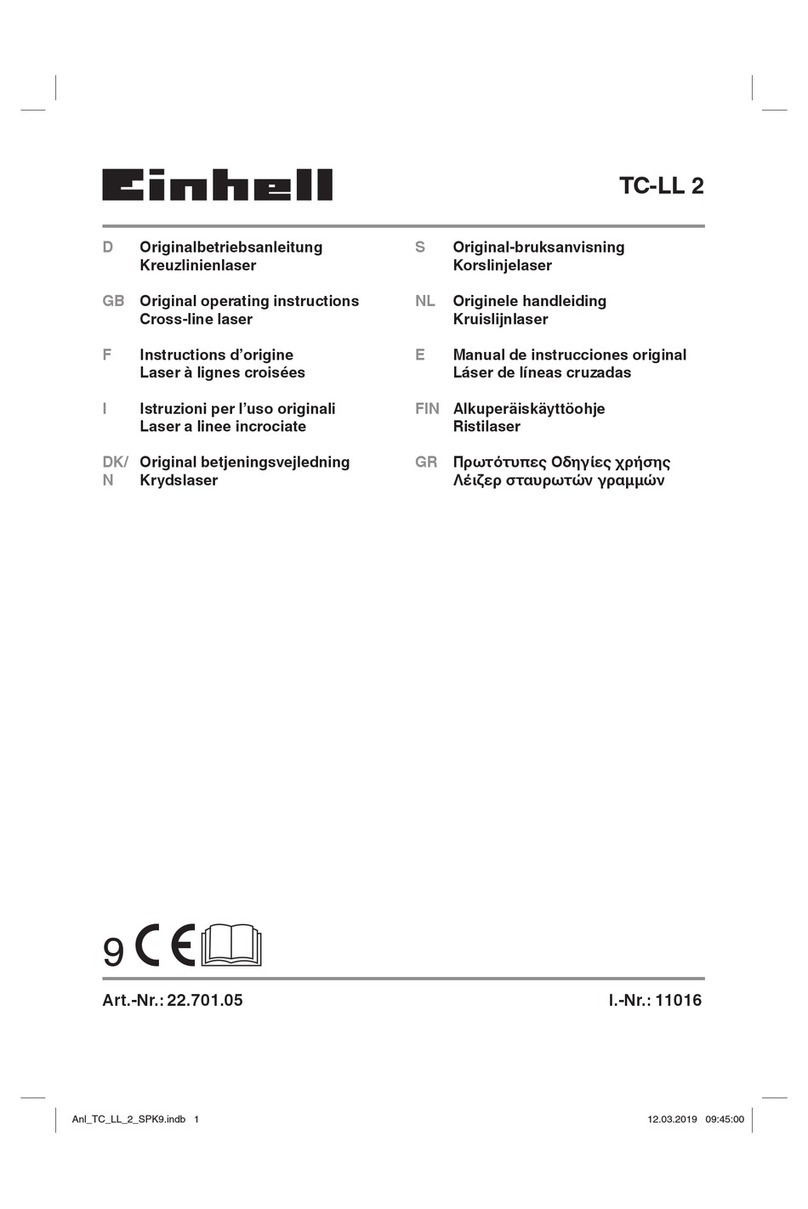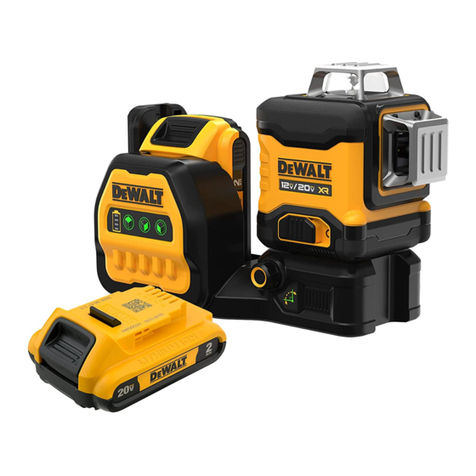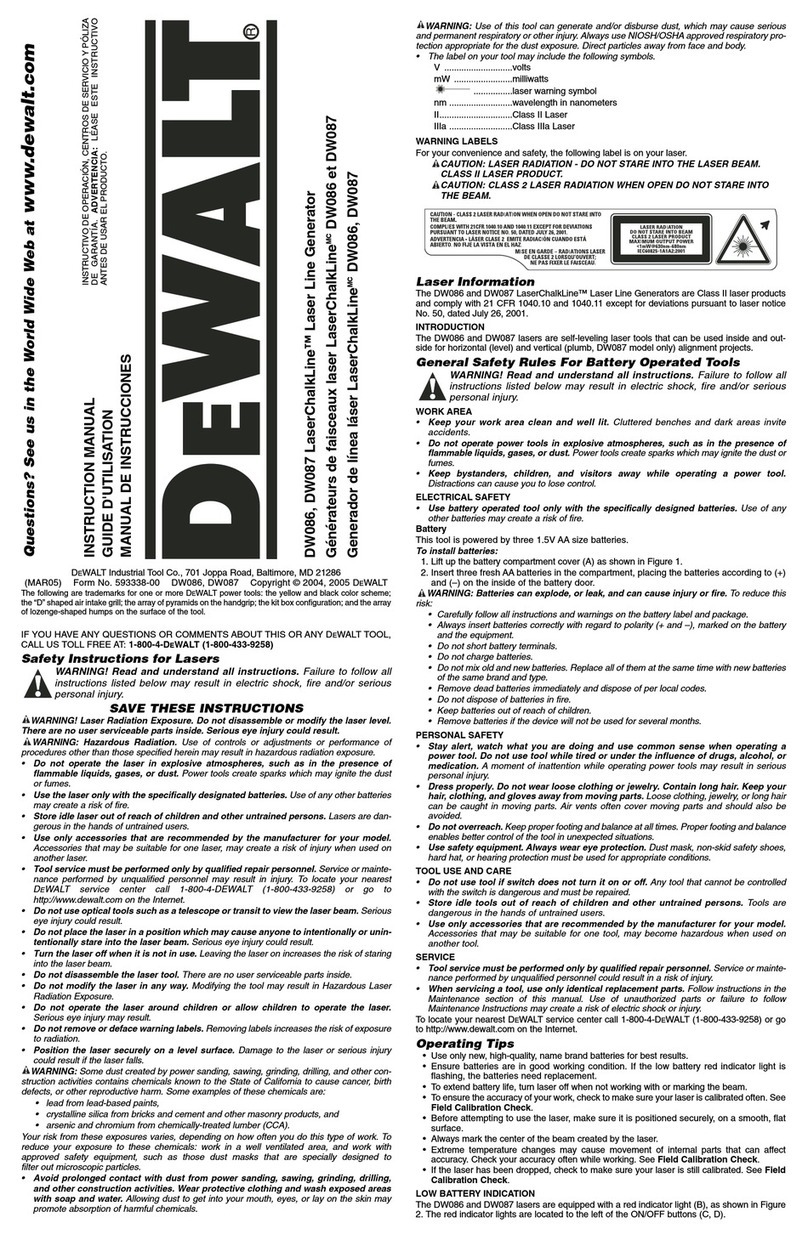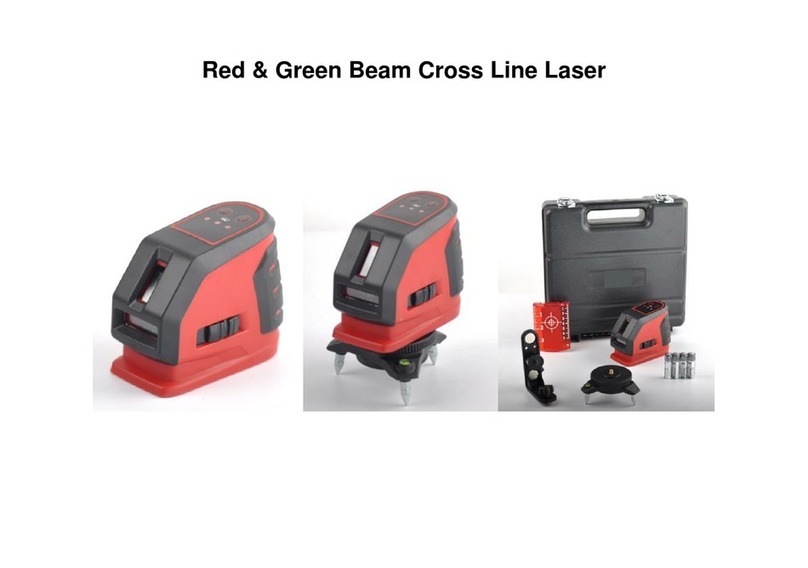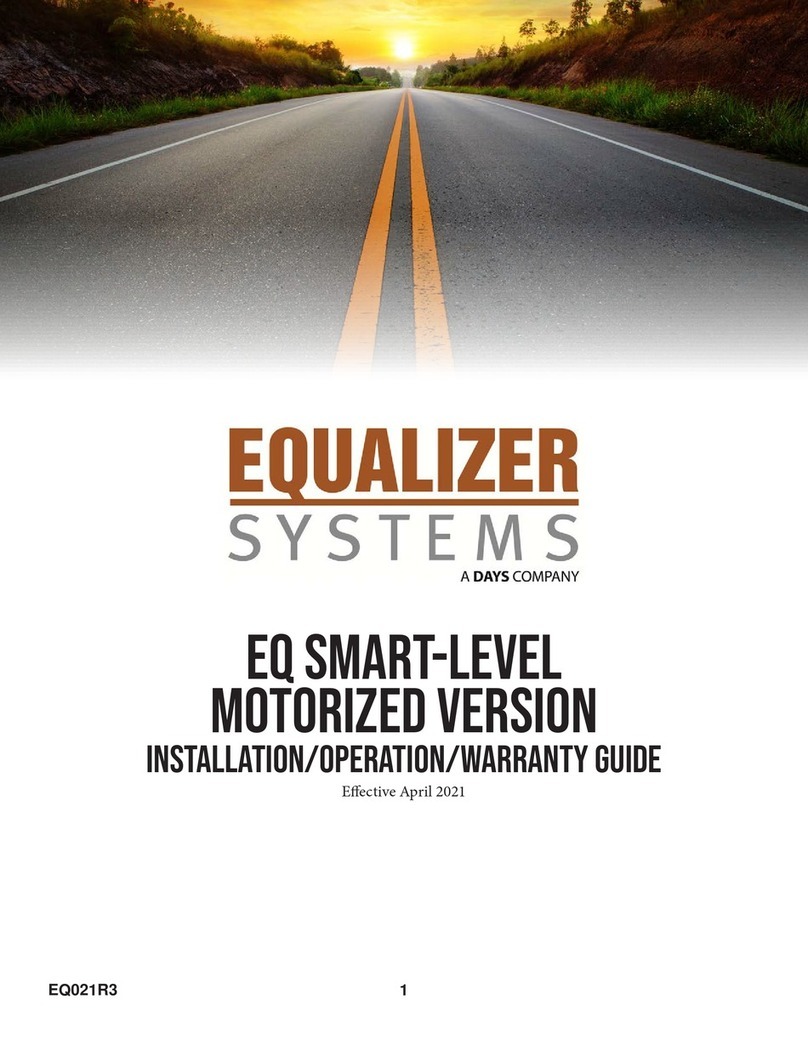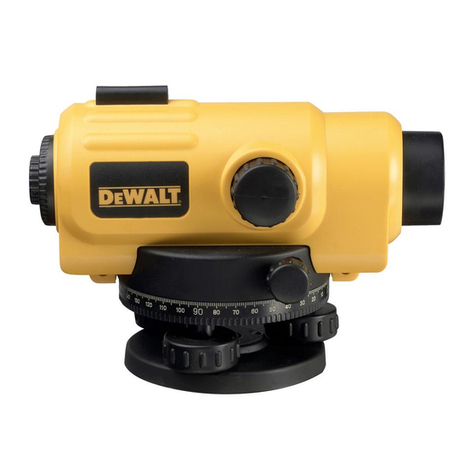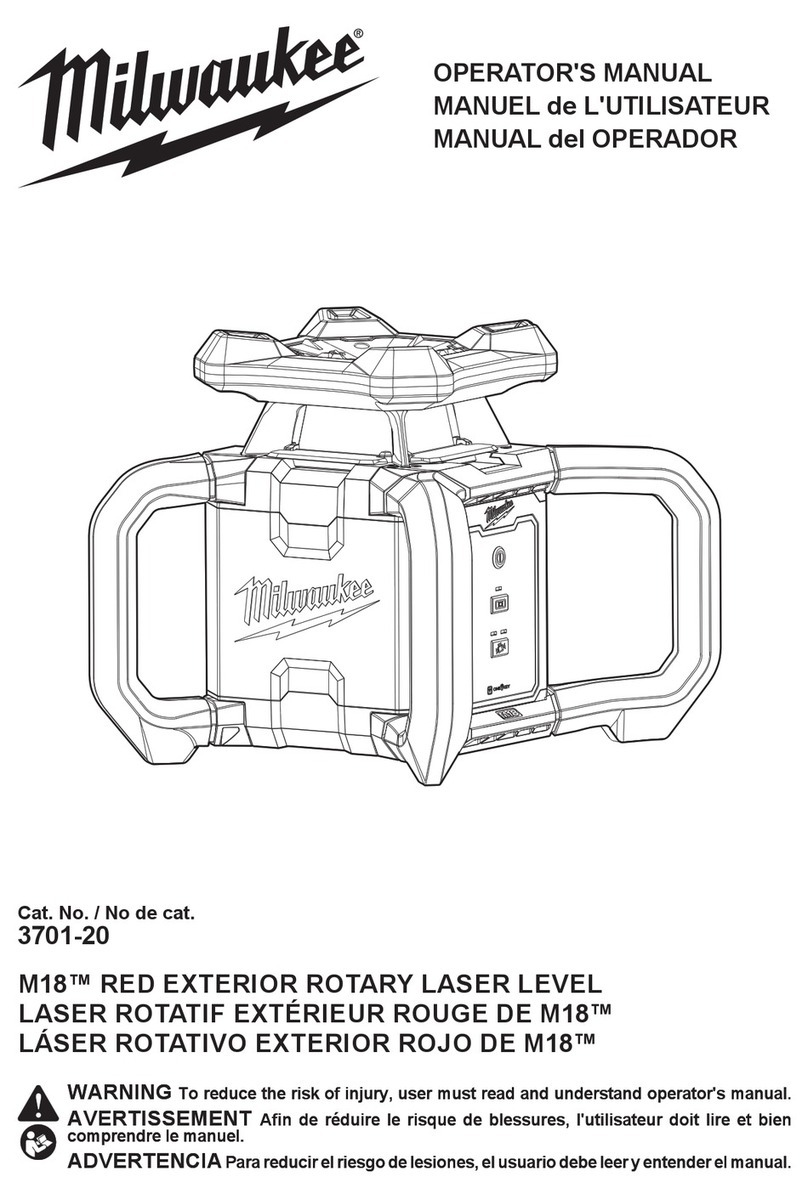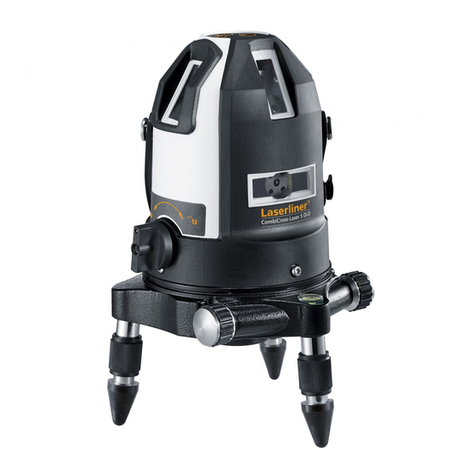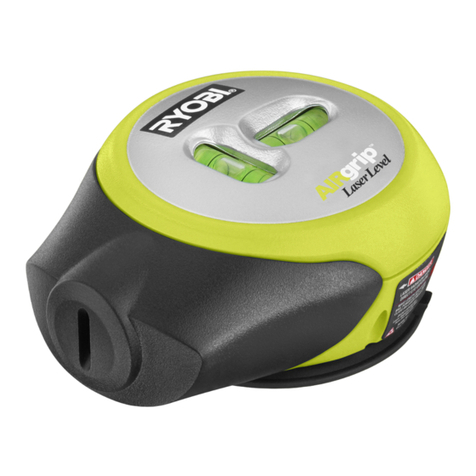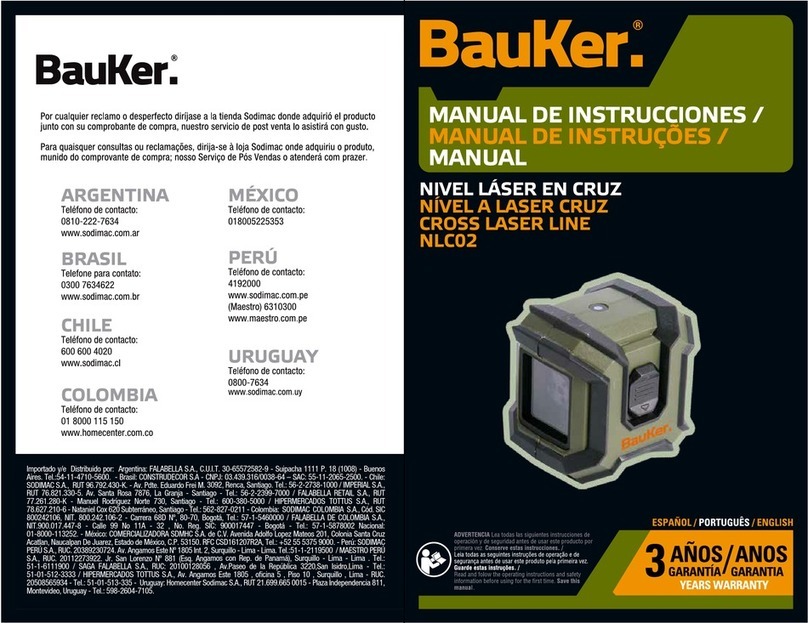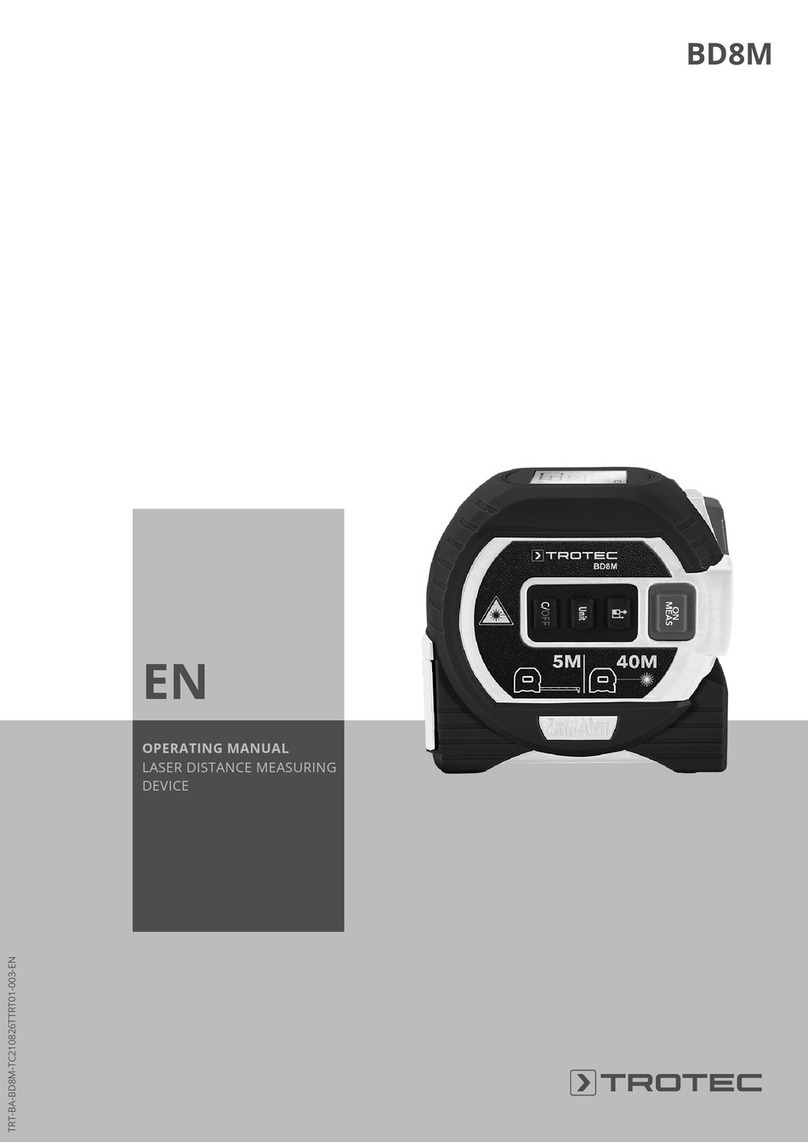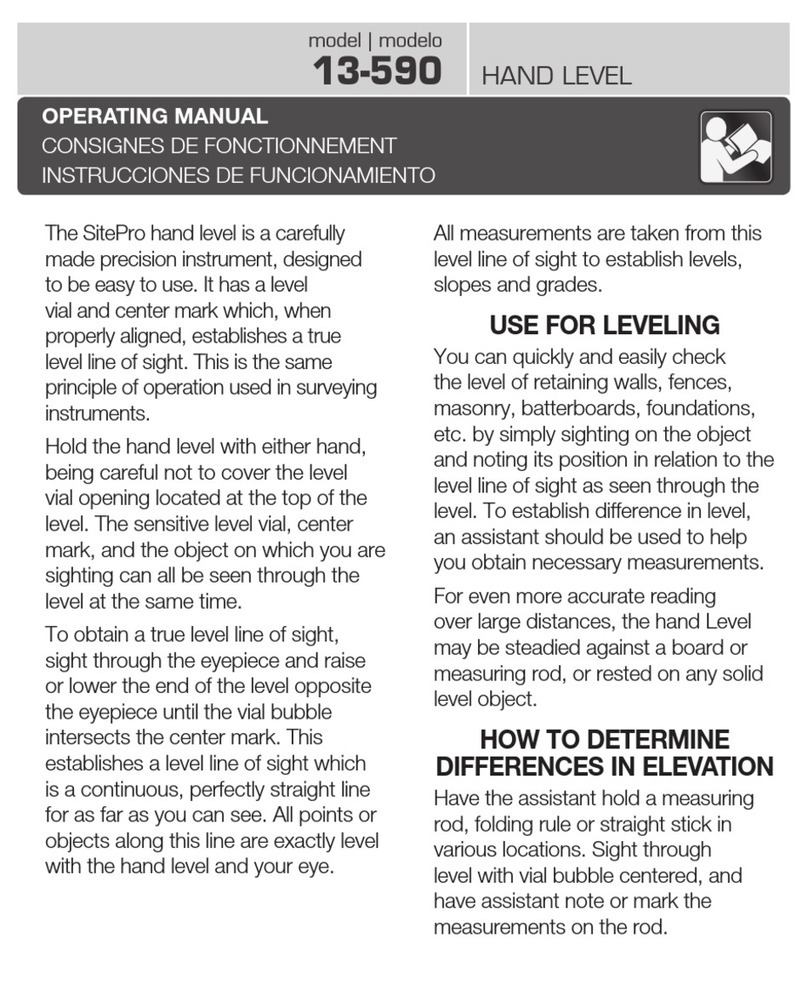Spectra Precision AL28M User manual

– 9 – – 10 – – 11 –
– 13 – – 14 –– 15 –
– 12 –
Features
01. Focusing knob
02. Sighting guide
03. Crosshairs’ adjustment screws (under cover)
04. Crosshairs’ focusing ring
05. Eyepiece
06. Horizontal rotation ring and angle index
07. Leveling screws
08. Base plate
09. Circular level adjustment screws
10. Horizontal tangent knob
11. Circular level
12. Mirror for reading circular level
13. Objective
Maintenance and Care
• As with all precision instruments, the auto level should be
transported and stored in its carrying case.
• When carrying the instrument mounted to a tripod, be sure to
carry it vertically rather than over your shoulder.
• Whenever possible, store the instrument in a dry, shady area.
• Wipe the instrument clean with a cloth. Clean the objective
and eyepieces with special care using a damp tissue or soft,
clean, lint-free cotton cloth.
• When working in wet weather, wipe off the instrument and
carrying case in the field and let them dry completely indoors
with the case open.
Safety Information
Included in this manual are Cautions and Notes. Each of
these words represents a level of danger or concern. A Caution
indicates a hazard or unsafe practice that could result in
minor injury or property damage. A Note indicates important
information unrelated to safety.
Establishing an Elevation
1. Set up and level the instrument.
2. Set the grade rod on a known elevation (30.55 m) and take a
grade rod reading (1.72 m).
3. Add the grade rod reading to the known elevation to get the
height of instrument or HI (1.72 + 30.55 = 32.27 m).
4. Subtract the elevation of the point you want to establish
(31.02 m) from the HI (32.27) to calculate the difference
between the two points (32.27 – 31.02 =1.25 m).
5. Go to the point you want to establish and adjust the height of
the grade rod until the calculated difference (1.25) is centered
in the crosshairs.
Taking Measurements
Determining the Difference in Elevation
How to Use the Instrument
Setting Up the Instrument
1. Set up the tripod at a height appropriate for your use.
Note: Make sure the tripod is stable and the tripod head is
relatively level.
2. Attach the instrument to the tripod.
3. Level the instrument using the circular level as a reference.
4. Focus the telescope crosshairs by turning the crosshairs’
focusing ring.
Aligning the Instrument
1. Align the telescope to the grade rod using the sighting guides.
2. Turn the focusing knob to bring the grade rod into sharp
focus. Precisely sight the center of the grade rod in the
telescope crosshairs using the horizontal tangent knob.
3. Check for parallax shift.
Note: No parallax exists if the crosshairs and the grade rod
graduations remain in coincidence even when you change
your viewing angle (move your eye up/down and left/right in
front of the eyepiece).
Note: After the bubble in the circular level has been centered,
the compensator corrects residual line-of-sight inclinations.
The compensator does not, however, eliminate any tilts
resulting from inadequate adjustment of the circular level or
line of sight. These must be checked regularly (see Adjusting
the Instrument for more information).
Taking a Distance Measurement
Note: The instrument’s stadia lines allow you to determine the
distance between the instrument and the grade rod.
1. Take readings at the upper stadia
line (1.436 m) and the lower stadia
line (1.152 m).
2. Calculate the difference between
the two readings (1.436 – 1.152 =
0.284 m).
3. Multiply the difference by 100
to get the distance between the
instrument and the grade rod
(.284 x 100 = 28.4).
Computation Example
Elevation
Center Line Reading 1.294 m
Distance Measurement
Upper Stadia Line Reading 1.436 m
Lower Stadia Line Reading 1.152 m
Difference 0.284 m
Distance (0.284 x 100) 28. 4 m
– 2 – – 3 – – 4 –
– 5 – – 6 –– 7 – – 8 –
7
5
4
8
13
12
10
11
9
3
6
2
1
1. Set up the instrument half way between two points (A and B).
2. Take a reading at point A (a1= 1.726 m) and another one at
point B (b1=1.259 m).
Note: A slight deviation of the line of sight from horizontal
will not cause any measuring error as long as the instrument
is set up approximately half way between the two points.
3. Subtract b1from a1to get the difference between the points
(d = 0.467 m).
Note: Point B is 0.467 higher than point A because the
difference is a positive number. If point B were lower than
point A, the number would be negative.
AL20M, AL24M, AL28M
AL24A, AL28A, AL32A
Auto Levels
User Guide
•
a1b1
A
B
1.259
1.726
0.467
www.spectraprecision.com

– 9 – – 10 – – 11 –
– 13 – – 14 –– 15 –
– 12 –
Features
01. Focusing knob
02. Sighting guide
03. Crosshairs’ adjustment screws (under cover)
04. Crosshairs’ focusing ring
05. Eyepiece
06. Horizontal rotation ring and angle index
07. Leveling screws
08. Base plate
09. Circular level adjustment screws
10. Horizontal tangent knob
11. Circular level
12. Mirror for reading circular level
13. Objective
Maintenance and Care
• As with all precision instruments, the auto level should be
transported and stored in its carrying case.
• When carrying the instrument mounted to a tripod, be sure to
carry it vertically rather than over your shoulder.
• Whenever possible, store the instrument in a dry, shady area.
• Wipe the instrument clean with a cloth. Clean the objective
and eyepieces with special care using a damp tissue or soft,
clean, lint-free cotton cloth.
• When working in wet weather, wipe off the instrument and
carrying case in the field and let them dry completely indoors
with the case open.
Safety Information
Included in this manual are Cautions and Notes. Each of
these words represents a level of danger or concern. A Caution
indicates a hazard or unsafe practice that could result in
minor injury or property damage. A Note indicates important
information unrelated to safety.
Establishing an Elevation
1. Set up and level the instrument.
2. Set the grade rod on a known elevation (30.55 m) and take a
grade rod reading (1.72 m).
3. Add the grade rod reading to the known elevation to get the
height of instrument or HI (1.72 + 30.55 = 32.27 m).
4. Subtract the elevation of the point you want to establish
(31.02 m) from the HI (32.27) to calculate the difference
between the two points (32.27 – 31.02 =1.25 m).
5. Go to the point you want to establish and adjust the height of
the grade rod until the calculated difference (1.25) is centered
in the crosshairs.
Taking Measurements
Determining the Difference in Elevation
How to Use the Instrument
Setting Up the Instrument
1. Set up the tripod at a height appropriate for your use.
Note: Make sure the tripod is stable and the tripod head is
relatively level.
2. Attach the instrument to the tripod.
3. Level the instrument using the circular level as a reference.
4. Focus the telescope crosshairs by turning the crosshairs’
focusing ring.
Aligning the Instrument
1. Align the telescope to the grade rod using the sighting guides.
2. Turn the focusing knob to bring the grade rod into sharp
focus. Precisely sight the center of the grade rod in the
telescope crosshairs using the horizontal tangent knob.
3. Check for parallax shift.
Note: No parallax exists if the crosshairs and the grade rod
graduations remain in coincidence even when you change
your viewing angle (move your eye up/down and left/right in
front of the eyepiece).
Note: After the bubble in the circular level has been centered,
the compensator corrects residual line-of-sight inclinations.
The compensator does not, however, eliminate any tilts
resulting from inadequate adjustment of the circular level or
line of sight. These must be checked regularly (see Adjusting
the Instrument for more information).
Taking a Distance Measurement
Note: The instrument’s stadia lines allow you to determine the
distance between the instrument and the grade rod.
1. Take readings at the upper stadia
line (1.436 m) and the lower stadia
line (1.152 m).
2. Calculate the difference between
the two readings (1.436 – 1.152 =
0.284 m).
3. Multiply the difference by 100
to get the distance between the
instrument and the grade rod
(.284 x 100 = 28.4).
Computation Example
Elevation
Center Line Reading 1.294 m
Distance Measurement
Upper Stadia Line Reading 1.436 m
Lower Stadia Line Reading 1.152 m
Difference 0.284 m
Distance (0.284 x 100) 28. 4 m
– 2 – – 3 – – 4 –
– 5 – – 6 –– 7 – – 8 –
7
5
4
8
13
12
10
11
9
3
6
2
1
1. Set up the instrument half way between two points (A and B).
2. Take a reading at point A (a1= 1.726 m) and another one at
point B (b1=1.259 m).
Note: A slight deviation of the line of sight from horizontal
will not cause any measuring error as long as the instrument
is set up approximately half way between the two points.
3. Subtract b1from a1to get the difference between the points
(d = 0.467 m).
Note: Point B is 0.467 higher than point A because the
difference is a positive number. If point B were lower than
point A, the number would be negative.
AL20M, AL24M, AL28M
AL24A, AL28A, AL32A
Auto Levels
User Guide
•
a1b1
A
B
1.259
1.726
0.467
www.spectraprecision.com

– 9 – – 10 – – 11 –
– 13 – – 14 –– 15 –
– 12 –
Features
01. Focusing knob
02. Sighting guide
03. Crosshairs’ adjustment screws (under cover)
04. Crosshairs’ focusing ring
05. Eyepiece
06. Horizontal rotation ring and angle index
07. Leveling screws
08. Base plate
09. Circular level adjustment screws
10. Horizontal tangent knob
11. Circular level
12. Mirror for reading circular level
13. Objective
Maintenance and Care
• As with all precision instruments, the auto level should be
transported and stored in its carrying case.
• When carrying the instrument mounted to a tripod, be sure to
carry it vertically rather than over your shoulder.
• Whenever possible, store the instrument in a dry, shady area.
• Wipe the instrument clean with a cloth. Clean the objective
and eyepieces with special care using a damp tissue or soft,
clean, lint-free cotton cloth.
• When working in wet weather, wipe off the instrument and
carrying case in the field and let them dry completely indoors
with the case open.
Safety Information
Included in this manual are Cautions and Notes. Each of
these words represents a level of danger or concern. A Caution
indicates a hazard or unsafe practice that could result in
minor injury or property damage. A Note indicates important
information unrelated to safety.
Establishing an Elevation
1. Set up and level the instrument.
2. Set the grade rod on a known elevation (30.55 m) and take a
grade rod reading (1.72 m).
3. Add the grade rod reading to the known elevation to get the
height of instrument or HI (1.72 + 30.55 = 32.27 m).
4. Subtract the elevation of the point you want to establish
(31.02 m) from the HI (32.27) to calculate the difference
between the two points (32.27 – 31.02 =1.25 m).
5. Go to the point you want to establish and adjust the height of
the grade rod until the calculated difference (1.25) is centered
in the crosshairs.
Taking Measurements
Determining the Difference in Elevation
How to Use the Instrument
Setting Up the Instrument
1. Set up the tripod at a height appropriate for your use.
Note: Make sure the tripod is stable and the tripod head is
relatively level.
2. Attach the instrument to the tripod.
3. Level the instrument using the circular level as a reference.
4. Focus the telescope crosshairs by turning the crosshairs’
focusing ring.
Aligning the Instrument
1. Align the telescope to the grade rod using the sighting guides.
2. Turn the focusing knob to bring the grade rod into sharp
focus. Precisely sight the center of the grade rod in the
telescope crosshairs using the horizontal tangent knob.
3. Check for parallax shift.
Note: No parallax exists if the crosshairs and the grade rod
graduations remain in coincidence even when you change
your viewing angle (move your eye up/down and left/right in
front of the eyepiece).
Note: After the bubble in the circular level has been centered,
the compensator corrects residual line-of-sight inclinations.
The compensator does not, however, eliminate any tilts
resulting from inadequate adjustment of the circular level or
line of sight. These must be checked regularly (see Adjusting
the Instrument for more information).
Taking a Distance Measurement
Note: The instrument’s stadia lines allow you to determine the
distance between the instrument and the grade rod.
1. Take readings at the upper stadia
line (1.436 m) and the lower stadia
line (1.152 m).
2. Calculate the difference between
the two readings (1.436 – 1.152 =
0.284 m).
3. Multiply the difference by 100
to get the distance between the
instrument and the grade rod
(.284 x 100 = 28.4).
Computation Example
Elevation
Center Line Reading 1.294 m
Distance Measurement
Upper Stadia Line Reading 1.436 m
Lower Stadia Line Reading 1.152 m
Difference 0.284 m
Distance (0.284 x 100) 28. 4 m
– 2 – – 3 – – 4 –
– 5 – – 6 –– 7 – – 8 –
7
5
4
8
13
12
10
11
9
3
6
2
1
1. Set up the instrument half way between two points (A and B).
2. Take a reading at point A (a1= 1.726 m) and another one at
point B (b1=1.259 m).
Note: A slight deviation of the line of sight from horizontal
will not cause any measuring error as long as the instrument
is set up approximately half way between the two points.
3. Subtract b1from a1to get the difference between the points
(d = 0.467 m).
Note: Point B is 0.467 higher than point A because the
difference is a positive number. If point B were lower than
point A, the number would be negative.
AL20M, AL24M, AL28M
AL24A, AL28A, AL32A
Auto Levels
User Guide
•
a1b1
A
B
1.259
1.726
0.467
www.spectraprecision.com

– 9 – – 10 – – 11 –
– 13 – – 14 –– 15 –
– 12 –
Features
01. Focusing knob
02. Sighting guide
03. Crosshairs’ adjustment screws (under cover)
04. Crosshairs’ focusing ring
05. Eyepiece
06. Horizontal rotation ring and angle index
07. Leveling screws
08. Base plate
09. Circular level adjustment screws
10. Horizontal tangent knob
11. Circular level
12. Mirror for reading circular level
13. Objective
Maintenance and Care
• As with all precision instruments, the auto level should be
transported and stored in its carrying case.
• When carrying the instrument mounted to a tripod, be sure to
carry it vertically rather than over your shoulder.
• Whenever possible, store the instrument in a dry, shady area.
• Wipe the instrument clean with a cloth. Clean the objective
and eyepieces with special care using a damp tissue or soft,
clean, lint-free cotton cloth.
• When working in wet weather, wipe off the instrument and
carrying case in the field and let them dry completely indoors
with the case open.
Safety Information
Included in this manual are Cautions and Notes. Each of
these words represents a level of danger or concern. A Caution
indicates a hazard or unsafe practice that could result in
minor injury or property damage. A Note indicates important
information unrelated to safety.
Establishing an Elevation
1. Set up and level the instrument.
2. Set the grade rod on a known elevation (30.55 m) and take a
grade rod reading (1.72 m).
3. Add the grade rod reading to the known elevation to get the
height of instrument or HI (1.72 + 30.55 = 32.27 m).
4. Subtract the elevation of the point you want to establish
(31.02 m) from the HI (32.27) to calculate the difference
between the two points (32.27 – 31.02 =1.25 m).
5. Go to the point you want to establish and adjust the height of
the grade rod until the calculated difference (1.25) is centered
in the crosshairs.
Taking Measurements
Determining the Difference in Elevation
How to Use the Instrument
Setting Up the Instrument
1. Set up the tripod at a height appropriate for your use.
Note: Make sure the tripod is stable and the tripod head is
relatively level.
2. Attach the instrument to the tripod.
3. Level the instrument using the circular level as a reference.
4. Focus the telescope crosshairs by turning the crosshairs’
focusing ring.
Aligning the Instrument
1. Align the telescope to the grade rod using the sighting guides.
2. Turn the focusing knob to bring the grade rod into sharp
focus. Precisely sight the center of the grade rod in the
telescope crosshairs using the horizontal tangent knob.
3. Check for parallax shift.
Note: No parallax exists if the crosshairs and the grade rod
graduations remain in coincidence even when you change
your viewing angle (move your eye up/down and left/right in
front of the eyepiece).
Note: After the bubble in the circular level has been centered,
the compensator corrects residual line-of-sight inclinations.
The compensator does not, however, eliminate any tilts
resulting from inadequate adjustment of the circular level or
line of sight. These must be checked regularly (see Adjusting
the Instrument for more information).
Taking a Distance Measurement
Note: The instrument’s stadia lines allow you to determine the
distance between the instrument and the grade rod.
1. Take readings at the upper stadia
line (1.436 m) and the lower stadia
line (1.152 m).
2. Calculate the difference between
the two readings (1.436 – 1.152 =
0.284 m).
3. Multiply the difference by 100
to get the distance between the
instrument and the grade rod
(.284 x 100 = 28.4).
Computation Example
Elevation
Center Line Reading 1.294 m
Distance Measurement
Upper Stadia Line Reading 1.436 m
Lower Stadia Line Reading 1.152 m
Difference 0.284 m
Distance (0.284 x 100) 28. 4 m
– 2 – – 3 – – 4 –
– 5 – – 6 –– 7 – – 8 –
7
5
4
8
13
12
10
11
9
3
6
2
1
1. Set up the instrument half way between two points (A and B).
2. Take a reading at point A (a1= 1.726 m) and another one at
point B (b1=1.259 m).
Note: A slight deviation of the line of sight from horizontal
will not cause any measuring error as long as the instrument
is set up approximately half way between the two points.
3. Subtract b1from a1to get the difference between the points
(d = 0.467 m).
Note: Point B is 0.467 higher than point A because the
difference is a positive number. If point B were lower than
point A, the number would be negative.
AL20M, AL24M, AL28M
AL24A, AL28A, AL32A
Auto Levels
User Guide
•
a1b1
A
B
1.259
1.726
0.467
www.spectraprecision.com

– 9 – – 10 – – 11 –
– 13 – – 14 –– 15 –
– 12 –
Features
01. Focusing knob
02. Sighting guide
03. Crosshairs’ adjustment screws (under cover)
04. Crosshairs’ focusing ring
05. Eyepiece
06. Horizontal rotation ring and angle index
07. Leveling screws
08. Base plate
09. Circular level adjustment screws
10. Horizontal tangent knob
11. Circular level
12. Mirror for reading circular level
13. Objective
Maintenance and Care
• As with all precision instruments, the auto level should be
transported and stored in its carrying case.
• When carrying the instrument mounted to a tripod, be sure to
carry it vertically rather than over your shoulder.
• Whenever possible, store the instrument in a dry, shady area.
• Wipe the instrument clean with a cloth. Clean the objective
and eyepieces with special care using a damp tissue or soft,
clean, lint-free cotton cloth.
• When working in wet weather, wipe off the instrument and
carrying case in the field and let them dry completely indoors
with the case open.
Safety Information
Included in this manual are Cautions and Notes. Each of
these words represents a level of danger or concern. A Caution
indicates a hazard or unsafe practice that could result in
minor injury or property damage. A Note indicates important
information unrelated to safety.
Establishing an Elevation
1. Set up and level the instrument.
2. Set the grade rod on a known elevation (30.55 m) and take a
grade rod reading (1.72 m).
3. Add the grade rod reading to the known elevation to get the
height of instrument or HI (1.72 + 30.55 = 32.27 m).
4. Subtract the elevation of the point you want to establish
(31.02 m) from the HI (32.27) to calculate the difference
between the two points (32.27 – 31.02 =1.25 m).
5. Go to the point you want to establish and adjust the height of
the grade rod until the calculated difference (1.25) is centered
in the crosshairs.
Taking Measurements
Determining the Difference in Elevation
How to Use the Instrument
Setting Up the Instrument
1. Set up the tripod at a height appropriate for your use.
Note: Make sure the tripod is stable and the tripod head is
relatively level.
2. Attach the instrument to the tripod.
3. Level the instrument using the circular level as a reference.
4. Focus the telescope crosshairs by turning the crosshairs’
focusing ring.
Aligning the Instrument
1. Align the telescope to the grade rod using the sighting guides.
2. Turn the focusing knob to bring the grade rod into sharp
focus. Precisely sight the center of the grade rod in the
telescope crosshairs using the horizontal tangent knob.
3. Check for parallax shift.
Note: No parallax exists if the crosshairs and the grade rod
graduations remain in coincidence even when you change
your viewing angle (move your eye up/down and left/right in
front of the eyepiece).
Note: After the bubble in the circular level has been centered,
the compensator corrects residual line-of-sight inclinations.
The compensator does not, however, eliminate any tilts
resulting from inadequate adjustment of the circular level or
line of sight. These must be checked regularly (see Adjusting
the Instrument for more information).
Taking a Distance Measurement
Note: The instrument’s stadia lines allow you to determine the
distance between the instrument and the grade rod.
1. Take readings at the upper stadia
line (1.436 m) and the lower stadia
line (1.152 m).
2. Calculate the difference between
the two readings (1.436 – 1.152 =
0.284 m).
3. Multiply the difference by 100
to get the distance between the
instrument and the grade rod
(.284 x 100 = 28.4).
Computation Example
Elevation
Center Line Reading 1.294 m
Distance Measurement
Upper Stadia Line Reading 1.436 m
Lower Stadia Line Reading 1.152 m
Difference 0.284 m
Distance (0.284 x 100) 28. 4 m
– 2 – – 3 – – 4 –
– 5 – – 6 –– 7 – – 8 –
7
5
4
8
13
12
10
11
9
3
6
2
1
1. Set up the instrument half way between two points (A and B).
2. Take a reading at point A (a1= 1.726 m) and another one at
point B (b1=1.259 m).
Note: A slight deviation of the line of sight from horizontal
will not cause any measuring error as long as the instrument
is set up approximately half way between the two points.
3. Subtract b1from a1to get the difference between the points
(d = 0.467 m).
Note: Point B is 0.467 higher than point A because the
difference is a positive number. If point B were lower than
point A, the number would be negative.
AL20M, AL24M, AL28M
AL24A, AL28A, AL32A
Auto Levels
User Guide
•
a1b1
A
B
1.259
1.726
0.467
www.spectraprecision.com

– 9 – – 10 – – 11 –
– 13 – – 14 –– 15 –
– 12 –
Features
01. Focusing knob
02. Sighting guide
03. Crosshairs’ adjustment screws (under cover)
04. Crosshairs’ focusing ring
05. Eyepiece
06. Horizontal rotation ring and angle index
07. Leveling screws
08. Base plate
09. Circular level adjustment screws
10. Horizontal tangent knob
11. Circular level
12. Mirror for reading circular level
13. Objective
Maintenance and Care
• As with all precision instruments, the auto level should be
transported and stored in its carrying case.
• When carrying the instrument mounted to a tripod, be sure to
carry it vertically rather than over your shoulder.
• Whenever possible, store the instrument in a dry, shady area.
• Wipe the instrument clean with a cloth. Clean the objective
and eyepieces with special care using a damp tissue or soft,
clean, lint-free cotton cloth.
• When working in wet weather, wipe off the instrument and
carrying case in the field and let them dry completely indoors
with the case open.
Safety Information
Included in this manual are Cautions and Notes. Each of
these words represents a level of danger or concern. A Caution
indicates a hazard or unsafe practice that could result in
minor injury or property damage. A Note indicates important
information unrelated to safety.
Establishing an Elevation
1. Set up and level the instrument.
2. Set the grade rod on a known elevation (30.55 m) and take a
grade rod reading (1.72 m).
3. Add the grade rod reading to the known elevation to get the
height of instrument or HI (1.72 + 30.55 = 32.27 m).
4. Subtract the elevation of the point you want to establish
(31.02 m) from the HI (32.27) to calculate the difference
between the two points (32.27 – 31.02 =1.25 m).
5. Go to the point you want to establish and adjust the height of
the grade rod until the calculated difference (1.25) is centered
in the crosshairs.
Taking Measurements
Determining the Difference in Elevation
How to Use the Instrument
Setting Up the Instrument
1. Set up the tripod at a height appropriate for your use.
Note: Make sure the tripod is stable and the tripod head is
relatively level.
2. Attach the instrument to the tripod.
3. Level the instrument using the circular level as a reference.
4. Focus the telescope crosshairs by turning the crosshairs’
focusing ring.
Aligning the Instrument
1. Align the telescope to the grade rod using the sighting guides.
2. Turn the focusing knob to bring the grade rod into sharp
focus. Precisely sight the center of the grade rod in the
telescope crosshairs using the horizontal tangent knob.
3. Check for parallax shift.
Note: No parallax exists if the crosshairs and the grade rod
graduations remain in coincidence even when you change
your viewing angle (move your eye up/down and left/right in
front of the eyepiece).
Note: After the bubble in the circular level has been centered,
the compensator corrects residual line-of-sight inclinations.
The compensator does not, however, eliminate any tilts
resulting from inadequate adjustment of the circular level or
line of sight. These must be checked regularly (see Adjusting
the Instrument for more information).
Taking a Distance Measurement
Note: The instrument’s stadia lines allow you to determine the
distance between the instrument and the grade rod.
1. Take readings at the upper stadia
line (1.436 m) and the lower stadia
line (1.152 m).
2. Calculate the difference between
the two readings (1.436 – 1.152 =
0.284 m).
3. Multiply the difference by 100
to get the distance between the
instrument and the grade rod
(.284 x 100 = 28.4).
Computation Example
Elevation
Center Line Reading 1.294 m
Distance Measurement
Upper Stadia Line Reading 1.436 m
Lower Stadia Line Reading 1.152 m
Difference 0.284 m
Distance (0.284 x 100) 28. 4 m
– 2 – – 3 – – 4 –
– 5 – – 6 –– 7 – – 8 –
7
5
4
8
13
12
10
11
9
3
6
2
1
1. Set up the instrument half way between two points (A and B).
2. Take a reading at point A (a1= 1.726 m) and another one at
point B (b1=1.259 m).
Note: A slight deviation of the line of sight from horizontal
will not cause any measuring error as long as the instrument
is set up approximately half way between the two points.
3. Subtract b1from a1to get the difference between the points
(d = 0.467 m).
Note: Point B is 0.467 higher than point A because the
difference is a positive number. If point B were lower than
point A, the number would be negative.
AL20M, AL24M, AL28M
AL24A, AL28A, AL32A
Auto Levels
User Guide
•
a1b1
A
B
1.259
1.726
0.467
www.spectraprecision.com

– 9 – – 10 – – 11 –
– 13 – – 14 –– 15 –
– 12 –
Features
01. Focusing knob
02. Sighting guide
03. Crosshairs’ adjustment screws (under cover)
04. Crosshairs’ focusing ring
05. Eyepiece
06. Horizontal rotation ring and angle index
07. Leveling screws
08. Base plate
09. Circular level adjustment screws
10. Horizontal tangent knob
11. Circular level
12. Mirror for reading circular level
13. Objective
Maintenance and Care
• As with all precision instruments, the auto level should be
transported and stored in its carrying case.
• When carrying the instrument mounted to a tripod, be sure to
carry it vertically rather than over your shoulder.
• Whenever possible, store the instrument in a dry, shady area.
• Wipe the instrument clean with a cloth. Clean the objective
and eyepieces with special care using a damp tissue or soft,
clean, lint-free cotton cloth.
• When working in wet weather, wipe off the instrument and
carrying case in the field and let them dry completely indoors
with the case open.
Safety Information
Included in this manual are Cautions and Notes. Each of
these words represents a level of danger or concern. A Caution
indicates a hazard or unsafe practice that could result in
minor injury or property damage. A Note indicates important
information unrelated to safety.
Establishing an Elevation
1. Set up and level the instrument.
2. Set the grade rod on a known elevation (30.55 m) and take a
grade rod reading (1.72 m).
3. Add the grade rod reading to the known elevation to get the
height of instrument or HI (1.72 + 30.55 = 32.27 m).
4. Subtract the elevation of the point you want to establish
(31.02 m) from the HI (32.27) to calculate the difference
between the two points (32.27 – 31.02 =1.25 m).
5. Go to the point you want to establish and adjust the height of
the grade rod until the calculated difference (1.25) is centered
in the crosshairs.
Taking Measurements
Determining the Difference in Elevation
How to Use the Instrument
Setting Up the Instrument
1. Set up the tripod at a height appropriate for your use.
Note: Make sure the tripod is stable and the tripod head is
relatively level.
2. Attach the instrument to the tripod.
3. Level the instrument using the circular level as a reference.
4. Focus the telescope crosshairs by turning the crosshairs’
focusing ring.
Aligning the Instrument
1. Align the telescope to the grade rod using the sighting guides.
2. Turn the focusing knob to bring the grade rod into sharp
focus. Precisely sight the center of the grade rod in the
telescope crosshairs using the horizontal tangent knob.
3. Check for parallax shift.
Note: No parallax exists if the crosshairs and the grade rod
graduations remain in coincidence even when you change
your viewing angle (move your eye up/down and left/right in
front of the eyepiece).
Note: After the bubble in the circular level has been centered,
the compensator corrects residual line-of-sight inclinations.
The compensator does not, however, eliminate any tilts
resulting from inadequate adjustment of the circular level or
line of sight. These must be checked regularly (see Adjusting
the Instrument for more information).
Taking a Distance Measurement
Note: The instrument’s stadia lines allow you to determine the
distance between the instrument and the grade rod.
1. Take readings at the upper stadia
line (1.436 m) and the lower stadia
line (1.152 m).
2. Calculate the difference between
the two readings (1.436 – 1.152 =
0.284 m).
3. Multiply the difference by 100
to get the distance between the
instrument and the grade rod
(.284 x 100 = 28.4).
Computation Example
Elevation
Center Line Reading 1.294 m
Distance Measurement
Upper Stadia Line Reading 1.436 m
Lower Stadia Line Reading 1.152 m
Difference 0.284 m
Distance (0.284 x 100) 28. 4 m
– 2 – – 3 – – 4 –
– 5 – – 6 –– 7 – – 8 –
7
5
4
8
13
12
10
11
9
3
6
2
1
1. Set up the instrument half way between two points (A and B).
2. Take a reading at point A (a1= 1.726 m) and another one at
point B (b1=1.259 m).
Note: A slight deviation of the line of sight from horizontal
will not cause any measuring error as long as the instrument
is set up approximately half way between the two points.
3. Subtract b1from a1to get the difference between the points
(d = 0.467 m).
Note: Point B is 0.467 higher than point A because the
difference is a positive number. If point B were lower than
point A, the number would be negative.
AL20M, AL24M, AL28M
AL24A, AL28A, AL32A
Auto Levels
User Guide
•
a1b1
A
B
1.259
1.726
0.467
www.spectraprecision.com

– 9 – – 10 – – 11 –
– 13 – – 14 –– 15 –
– 12 –
Features
01. Focusing knob
02. Sighting guide
03. Crosshairs’ adjustment screws (under cover)
04. Crosshairs’ focusing ring
05. Eyepiece
06. Horizontal rotation ring and angle index
07. Leveling screws
08. Base plate
09. Circular level adjustment screws
10. Horizontal tangent knob
11. Circular level
12. Mirror for reading circular level
13. Objective
Maintenance and Care
• As with all precision instruments, the auto level should be
transported and stored in its carrying case.
• When carrying the instrument mounted to a tripod, be sure to
carry it vertically rather than over your shoulder.
• Whenever possible, store the instrument in a dry, shady area.
• Wipe the instrument clean with a cloth. Clean the objective
and eyepieces with special care using a damp tissue or soft,
clean, lint-free cotton cloth.
• When working in wet weather, wipe off the instrument and
carrying case in the field and let them dry completely indoors
with the case open.
Safety Information
Included in this manual are Cautions and Notes. Each of
these words represents a level of danger or concern. A Caution
indicates a hazard or unsafe practice that could result in
minor injury or property damage. A Note indicates important
information unrelated to safety.
Establishing an Elevation
1. Set up and level the instrument.
2. Set the grade rod on a known elevation (30.55 m) and take a
grade rod reading (1.72 m).
3. Add the grade rod reading to the known elevation to get the
height of instrument or HI (1.72 + 30.55 = 32.27 m).
4. Subtract the elevation of the point you want to establish
(31.02 m) from the HI (32.27) to calculate the difference
between the two points (32.27 – 31.02 =1.25 m).
5. Go to the point you want to establish and adjust the height of
the grade rod until the calculated difference (1.25) is centered
in the crosshairs.
Taking Measurements
Determining the Difference in Elevation
How to Use the Instrument
Setting Up the Instrument
1. Set up the tripod at a height appropriate for your use.
Note: Make sure the tripod is stable and the tripod head is
relatively level.
2. Attach the instrument to the tripod.
3. Level the instrument using the circular level as a reference.
4. Focus the telescope crosshairs by turning the crosshairs’
focusing ring.
Aligning the Instrument
1. Align the telescope to the grade rod using the sighting guides.
2. Turn the focusing knob to bring the grade rod into sharp
focus. Precisely sight the center of the grade rod in the
telescope crosshairs using the horizontal tangent knob.
3. Check for parallax shift.
Note: No parallax exists if the crosshairs and the grade rod
graduations remain in coincidence even when you change
your viewing angle (move your eye up/down and left/right in
front of the eyepiece).
Note: After the bubble in the circular level has been centered,
the compensator corrects residual line-of-sight inclinations.
The compensator does not, however, eliminate any tilts
resulting from inadequate adjustment of the circular level or
line of sight. These must be checked regularly (see Adjusting
the Instrument for more information).
Taking a Distance Measurement
Note: The instrument’s stadia lines allow you to determine the
distance between the instrument and the grade rod.
1. Take readings at the upper stadia
line (1.436 m) and the lower stadia
line (1.152 m).
2. Calculate the difference between
the two readings (1.436 – 1.152 =
0.284 m).
3. Multiply the difference by 100
to get the distance between the
instrument and the grade rod
(.284 x 100 = 28.4).
Computation Example
Elevation
Center Line Reading 1.294 m
Distance Measurement
Upper Stadia Line Reading 1.436 m
Lower Stadia Line Reading 1.152 m
Difference 0.284 m
Distance (0.284 x 100) 28. 4 m
– 2 – – 3 – – 4 –
– 5 – – 6 –– 7 – – 8 –
7
5
4
8
13
12
10
11
9
3
6
2
1
1. Set up the instrument half way between two points (A and B).
2. Take a reading at point A (a1= 1.726 m) and another one at
point B (b1=1.259 m).
Note: A slight deviation of the line of sight from horizontal
will not cause any measuring error as long as the instrument
is set up approximately half way between the two points.
3. Subtract b1from a1to get the difference between the points
(d = 0.467 m).
Note: Point B is 0.467 higher than point A because the
difference is a positive number. If point B were lower than
point A, the number would be negative.
AL20M, AL24M, AL28M
AL24A, AL28A, AL32A
Auto Levels
User Guide
•
a1b1
A
B
1.259
1.726
0.467
www.spectraprecision.com

– 9 – – 10 – – 11 –
– 13 – – 14 –– 15 –
– 12 –
Adjusting the Instrument
Circular Level
1. Set up the instrument.
2. Center the bubble of the circular level using the leveling
screws.
3. Turn the telescope 180° (200 gon).
4 Check to see whether the bubble is still centered in the circle.
If it isn’t, eliminate one half of the error with the leveling
screws and the other half with the two adjustment screws for
the circular level.
5. Repeat the process until the bubble remains centered when
the instrument is turned.
Taking an Angle Measurement
1. Set up the tripod so that it is over a hub.
Note: Make sure the tripod is stable and the tripod head is
relatively level.
2. Hang a plumb-bob from the plumb-bob hook on the tripod.
Note: Make sure the plumb-bob is over the hub.
3. Attach the instrument to the tripod.
4. Center the plumb-bob over the pin in the hub by varying
the length of the tripod legs or by shifting the instrument
on the tripod.
5. Accurately align the telescope to the first target using the
sighting guides and a horizontal tangent knob.
Note: The first target is a known point.
6. Set the horizontal rotation ring to 0.
7. Accurately align the telescope to the second target and read
the angle.
Line of Sight
© 2023, Spectra Precision LLC. All rights reserved.
PN 1211-0200 Rev C (05/23)
– 9 – – 10 – – 11 –
– 13 – – 14 –– 15 –
– 12 –
4. Move the instrument and reset it up so that it is about 2 m
behind point B.
5. Take another reading at point B (b2= 1.462 m).
6. Add b2to d to get value c (1.462 + 1.487 = 2.949 m).
7. Take another reading at point A (a2).
8. Compare value c (2.949) to a2. If the line of sight is correct,
both numbers should be the same. If they differ by more
than 4 mm, reset the grade rod on point A and turn the
crosshairs adjustment screws (unscrew the cover to expose
them) until value c (2.949) is centered in the crosshairs.
Caution: The upper and lower adjustment screws are
counter-screws and must not be set too tightly.
9. Repeat the process until the line of sight is correct
(c and a2are the same).
1. Set up the instrument half way between two points (A and B)
that are 30 to 40 m apart.
2. Take a reading at point A (a1= 2.423 m) and another one at
point B (b1= 0.936 m).
3. Subtract b1from a1to get the difference between the points
(d = +1.487 m). Make sure you note whether value d is a
positive or negative number.
Note: Because the distance from the instrument to each of
the points is equal, the difference in elevation is correct even
if the line of sight is out of adjustment.
a
2
b
2
a
1
b
1
A
B
a
2
= 2.423 b
2
= 1.462
+b
1
= 0.936 -d
= 1.487
d
= +1.487 c
= 2.949
Service Request
To locate your local dealer or authorized Spectra Precision
Service Center outside the U.S.A for service, accessories, or
spare parts, contact one of our offices listed below.
AL32A AL28A AL24A AL28M AL24M AL20M
Magnication 32X 28X 24X 28X 24X 20X
Dampening Air Air Air Magnetic Magnetic Magnetic
Accuracy* +/-1.0mm +/-1.5mm +/-2.0mm +/-1.5mm +/-2.0mm +/-2.5mm
Leveling Accuracy @
50m 0.5mm 0.7mm 1.2mm 2.5mm 2.5mm 2.5mm
Telescope:
Aperture 30mm (1.2 in.)
Telescope image Erect
Field of view angle 1⁰20'
Shortest focus distance 0.60m (1.97 ft.)
Stadia constant 100
Addition constant 0
Dimensions (L x W x H):
Instrument 103 x 190 x 135mm (5.2 x 7.5 x 5.3 in.)
Case 170 x 280 x 190mm (6.7 x 11 x 7.5 in.)
Weight:
Instrument 1.6 kg (3.5 lb)
Case 1.25kg (2.75 lb)
* Standard deviation according to DIN 18723 on 1 km of double leveling
Specifications
Americas
Spectra Precision (USA) LLC
3265 Logistics Lane, Suite 200
Dayton, OH 45377 USA
888-527-3771 (Toll Free)
Europe, Middle East, Africa
Spectra Precision (Kaiserslautern) GmbH
Am Sportplatz 5
67661 Kaiserslautern
Germany
+49-6142-2100-0 Phone
www.spectraprecision.com
Warranty
Spectra Precision LLC warrants the AL auto levels to be free of
defects in material and workmanship for a period of 2 years.
Spectra Precision LLC or its authorized service center will repair
or replace, at its option, any defective part, or the entire
product, for which notice has been given during the warranty
period. If required, travel and per diem expenses to and from
the place where repairs are made will be charged to the
customer at the prevailing rates. Customers should send the
product to the nearest authorized service center for warranty
repairs or exchange, freight prepaid. Any evidence of negligent,
abnormal use, accident, or any attempt to repair the product by
other than factory-authorized personnel using Spectra Precision
LLC certified or recommended parts, automatically voids the
warranty. Special precautions have been taken to ensure the
calibration of the laser; however, calibration is not covered by
this warranty. Maintenance of the calibration is the
responsibility of the user. The foregoing states the entire liability
of Spectra Precision LLC regarding the purchase and use of its
equipment. Spectra Precision LLC will not be held responsible
for any consequential loss or damage of any kind. This warranty
is in lieu of all other warranties, except as set forth above,
including any implied warranty merchantability of fitness for a
particular purpose, are hereby disclaimed. This warranty is in
lieu of all other warranties, expressed or implied.

– 9 – – 10 – – 11 –
– 13 – – 14 –– 15 –
– 12 –
Adjusting the Instrument
Circular Level
1. Set up the instrument.
2. Center the bubble of the circular level using the leveling
screws.
3. Turn the telescope 180° (200 gon).
4 Check to see whether the bubble is still centered in the circle.
If it isn’t, eliminate one half of the error with the leveling
screws and the other half with the two adjustment screws for
the circular level.
5. Repeat the process until the bubble remains centered when
the instrument is turned.
Taking an Angle Measurement
1. Set up the tripod so that it is over a hub.
Note: Make sure the tripod is stable and the tripod head is
relatively level.
2. Hang a plumb-bob from the plumb-bob hook on the tripod.
Note: Make sure the plumb-bob is over the hub.
3. Attach the instrument to the tripod.
4. Center the plumb-bob over the pin in the hub by varying
the length of the tripod legs or by shifting the instrument
on the tripod.
5. Accurately align the telescope to the first target using the
sighting guides and a horizontal tangent knob.
Note: The first target is a known point.
6. Set the horizontal rotation ring to 0.
7. Accurately align the telescope to the second target and read
the angle.
Line of Sight
© 2023, Spectra Precision LLC. All rights reserved.
PN 1211-0200 Rev C (05/23)
– 9 – – 10 – – 11 –
– 13 – – 14 –– 15 –
– 12 –
4. Move the instrument and reset it up so that it is about 2 m
behind point B.
5. Take another reading at point B (b2= 1.462 m).
6. Add b2to d to get value c (1.462 + 1.487 = 2.949 m).
7. Take another reading at point A (a2).
8. Compare value c (2.949) to a2. If the line of sight is correct,
both numbers should be the same. If they differ by more
than 4 mm, reset the grade rod on point A and turn the
crosshairs adjustment screws (unscrew the cover to expose
them) until value c (2.949) is centered in the crosshairs.
Caution: The upper and lower adjustment screws are
counter-screws and must not be set too tightly.
9. Repeat the process until the line of sight is correct
(c and a2are the same).
1. Set up the instrument half way between two points (A and B)
that are 30 to 40 m apart.
2. Take a reading at point A (a1= 2.423 m) and another one at
point B (b1= 0.936 m).
3. Subtract b1from a1to get the difference between the points
(d = +1.487 m). Make sure you note whether value d is a
positive or negative number.
Note: Because the distance from the instrument to each of
the points is equal, the difference in elevation is correct even
if the line of sight is out of adjustment.
a
2
b
2
a
1
b
1
A
B
a
2
= 2.423 b
2
= 1.462
+b
1
= 0.936 -d
= 1.487
d
= +1.487 c
= 2.949
Service Request
To locate your local dealer or authorized Spectra Precision
Service Center outside the U.S.A for service, accessories, or
spare parts, contact one of our offices listed below.
AL32A AL28A AL24A AL28M AL24M AL20M
Magnication 32X 28X 24X 28X 24X 20X
Dampening Air Air Air Magnetic Magnetic Magnetic
Accuracy* +/-1.0mm +/-1.5mm +/-2.0mm +/-1.5mm +/-2.0mm +/-2.5mm
Leveling Accuracy @
50m 0.5mm 0.7mm 1.2mm 2.5mm 2.5mm 2.5mm
Telescope:
Aperture 30mm (1.2 in.)
Telescope image Erect
Field of view angle 1⁰20'
Shortest focus distance 0.60m (1.97 ft.)
Stadia constant 100
Addition constant 0
Dimensions (L x W x H):
Instrument 103 x 190 x 135mm (5.2 x 7.5 x 5.3 in.)
Case 170 x 280 x 190mm (6.7 x 11 x 7.5 in.)
Weight:
Instrument 1.6 kg (3.5 lb)
Case 1.25kg (2.75 lb)
* Standard deviation according to DIN 18723 on 1 km of double leveling
Specifications
Americas
Spectra Precision (USA) LLC
3265 Logistics Lane, Suite 200
Dayton, OH 45377 USA
888-527-3771 (Toll Free)
Europe, Middle East, Africa
Spectra Precision (Kaiserslautern) GmbH
Am Sportplatz 5
67661 Kaiserslautern
Germany
+49-6142-2100-0 Phone
www.spectraprecision.com
Warranty
Spectra Precision LLC warrants the AL auto levels to be free of
defects in material and workmanship for a period of 2 years.
Spectra Precision LLC or its authorized service center will repair
or replace, at its option, any defective part, or the entire
product, for which notice has been given during the warranty
period. If required, travel and per diem expenses to and from
the place where repairs are made will be charged to the
customer at the prevailing rates. Customers should send the
product to the nearest authorized service center for warranty
repairs or exchange, freight prepaid. Any evidence of negligent,
abnormal use, accident, or any attempt to repair the product by
other than factory-authorized personnel using Spectra Precision
LLC certified or recommended parts, automatically voids the
warranty. Special precautions have been taken to ensure the
calibration of the laser; however, calibration is not covered by
this warranty. Maintenance of the calibration is the
responsibility of the user. The foregoing states the entire liability
of Spectra Precision LLC regarding the purchase and use of its
equipment. Spectra Precision LLC will not be held responsible
for any consequential loss or damage of any kind. This warranty
is in lieu of all other warranties, except as set forth above,
including any implied warranty merchantability of fitness for a
particular purpose, are hereby disclaimed. This warranty is in
lieu of all other warranties, expressed or implied.

– 9 – – 10 – – 11 –
– 13 – – 14 –– 15 –
– 12 –
Adjusting the Instrument
Circular Level
1. Set up the instrument.
2. Center the bubble of the circular level using the leveling
screws.
3. Turn the telescope 180° (200 gon).
4 Check to see whether the bubble is still centered in the circle.
If it isn’t, eliminate one half of the error with the leveling
screws and the other half with the two adjustment screws for
the circular level.
5. Repeat the process until the bubble remains centered when
the instrument is turned.
Taking an Angle Measurement
1. Set up the tripod so that it is over a hub.
Note: Make sure the tripod is stable and the tripod head is
relatively level.
2. Hang a plumb-bob from the plumb-bob hook on the tripod.
Note: Make sure the plumb-bob is over the hub.
3. Attach the instrument to the tripod.
4. Center the plumb-bob over the pin in the hub by varying
the length of the tripod legs or by shifting the instrument
on the tripod.
5. Accurately align the telescope to the first target using the
sighting guides and a horizontal tangent knob.
Note: The first target is a known point.
6. Set the horizontal rotation ring to 0.
7. Accurately align the telescope to the second target and read
the angle.
Line of Sight
© 2023, Spectra Precision LLC. All rights reserved.
PN 1211-0200 Rev C (05/23)
– 9 – – 10 – – 11 –
– 13 – – 14 –– 15 –
– 12 –
4. Move the instrument and reset it up so that it is about 2 m
behind point B.
5. Take another reading at point B (b2= 1.462 m).
6. Add b2to d to get value c (1.462 + 1.487 = 2.949 m).
7. Take another reading at point A (a2).
8. Compare value c (2.949) to a2. If the line of sight is correct,
both numbers should be the same. If they differ by more
than 4 mm, reset the grade rod on point A and turn the
crosshairs adjustment screws (unscrew the cover to expose
them) until value c (2.949) is centered in the crosshairs.
Caution: The upper and lower adjustment screws are
counter-screws and must not be set too tightly.
9. Repeat the process until the line of sight is correct
(c and a2are the same).
1. Set up the instrument half way between two points (A and B)
that are 30 to 40 m apart.
2. Take a reading at point A (a1= 2.423 m) and another one at
point B (b1= 0.936 m).
3. Subtract b1from a1to get the difference between the points
(d = +1.487 m). Make sure you note whether value d is a
positive or negative number.
Note: Because the distance from the instrument to each of
the points is equal, the difference in elevation is correct even
if the line of sight is out of adjustment.
a
2
b
2
a
1
b
1
A
B
a
2
= 2.423 b
2
= 1.462
+b
1
= 0.936 -d
= 1.487
d
= +1.487 c
= 2.949
Service Request
To locate your local dealer or authorized Spectra Precision
Service Center outside the U.S.A for service, accessories, or
spare parts, contact one of our offices listed below.
AL32A AL28A AL24A AL28M AL24M AL20M
Magnication 32X 28X 24X 28X 24X 20X
Dampening Air Air Air Magnetic Magnetic Magnetic
Accuracy* +/-1.0mm +/-1.5mm +/-2.0mm +/-1.5mm +/-2.0mm +/-2.5mm
Leveling Accuracy @
50m 0.5mm 0.7mm 1.2mm 2.5mm 2.5mm 2.5mm
Telescope:
Aperture 30mm (1.2 in.)
Telescope image Erect
Field of view angle 1⁰20'
Shortest focus distance 0.60m (1.97 ft.)
Stadia constant 100
Addition constant 0
Dimensions (L x W x H):
Instrument 103 x 190 x 135mm (5.2 x 7.5 x 5.3 in.)
Case 170 x 280 x 190mm (6.7 x 11 x 7.5 in.)
Weight:
Instrument 1.6 kg (3.5 lb)
Case 1.25kg (2.75 lb)
* Standard deviation according to DIN 18723 on 1 km of double leveling
Specifications
Americas
Spectra Precision (USA) LLC
3265 Logistics Lane, Suite 200
Dayton, OH 45377 USA
888-527-3771 (Toll Free)
Europe, Middle East, Africa
Spectra Precision (Kaiserslautern) GmbH
Am Sportplatz 5
67661 Kaiserslautern
Germany
+49-6142-2100-0 Phone
www.spectraprecision.com
Warranty
Spectra Precision LLC warrants the AL auto levels to be free of
defects in material and workmanship for a period of 2 years.
Spectra Precision LLC or its authorized service center will repair
or replace, at its option, any defective part, or the entire
product, for which notice has been given during the warranty
period. If required, travel and per diem expenses to and from
the place where repairs are made will be charged to the
customer at the prevailing rates. Customers should send the
product to the nearest authorized service center for warranty
repairs or exchange, freight prepaid. Any evidence of negligent,
abnormal use, accident, or any attempt to repair the product by
other than factory-authorized personnel using Spectra Precision
LLC certified or recommended parts, automatically voids the
warranty. Special precautions have been taken to ensure the
calibration of the laser; however, calibration is not covered by
this warranty. Maintenance of the calibration is the
responsibility of the user. The foregoing states the entire liability
of Spectra Precision LLC regarding the purchase and use of its
equipment. Spectra Precision LLC will not be held responsible
for any consequential loss or damage of any kind. This warranty
is in lieu of all other warranties, except as set forth above,
including any implied warranty merchantability of fitness for a
particular purpose, are hereby disclaimed. This warranty is in
lieu of all other warranties, expressed or implied.

– 9 – – 10 – – 11 –
– 13 – – 14 –– 15 –
– 12 –
Adjusting the Instrument
Circular Level
1. Set up the instrument.
2. Center the bubble of the circular level using the leveling
screws.
3. Turn the telescope 180° (200 gon).
4 Check to see whether the bubble is still centered in the circle.
If it isn’t, eliminate one half of the error with the leveling
screws and the other half with the two adjustment screws for
the circular level.
5. Repeat the process until the bubble remains centered when
the instrument is turned.
Taking an Angle Measurement
1. Set up the tripod so that it is over a hub.
Note: Make sure the tripod is stable and the tripod head is
relatively level.
2. Hang a plumb-bob from the plumb-bob hook on the tripod.
Note: Make sure the plumb-bob is over the hub.
3. Attach the instrument to the tripod.
4. Center the plumb-bob over the pin in the hub by varying
the length of the tripod legs or by shifting the instrument
on the tripod.
5. Accurately align the telescope to the first target using the
sighting guides and a horizontal tangent knob.
Note: The first target is a known point.
6. Set the horizontal rotation ring to 0.
7. Accurately align the telescope to the second target and read
the angle.
Line of Sight
© 2023, Spectra Precision LLC. All rights reserved.
PN 1211-0200 Rev C (05/23)
– 9 – – 10 – – 11 –
– 13 – – 14 –– 15 –
– 12 –
4. Move the instrument and reset it up so that it is about 2 m
behind point B.
5. Take another reading at point B (b2= 1.462 m).
6. Add b2to d to get value c (1.462 + 1.487 = 2.949 m).
7. Take another reading at point A (a2).
8. Compare value c (2.949) to a2. If the line of sight is correct,
both numbers should be the same. If they differ by more
than 4 mm, reset the grade rod on point A and turn the
crosshairs adjustment screws (unscrew the cover to expose
them) until value c (2.949) is centered in the crosshairs.
Caution: The upper and lower adjustment screws are
counter-screws and must not be set too tightly.
9. Repeat the process until the line of sight is correct
(c and a2are the same).
1. Set up the instrument half way between two points (A and B)
that are 30 to 40 m apart.
2. Take a reading at point A (a1= 2.423 m) and another one at
point B (b1= 0.936 m).
3. Subtract b1from a1to get the difference between the points
(d = +1.487 m). Make sure you note whether value d is a
positive or negative number.
Note: Because the distance from the instrument to each of
the points is equal, the difference in elevation is correct even
if the line of sight is out of adjustment.
a
2
b
2
a
1
b
1
A
B
a
2
= 2.423 b
2
= 1.462
+b
1
= 0.936 -d
= 1.487
d
= +1.487 c
= 2.949
Service Request
To locate your local dealer or authorized Spectra Precision
Service Center outside the U.S.A for service, accessories, or
spare parts, contact one of our offices listed below.
AL32A AL28A AL24A AL28M AL24M AL20M
Magnication 32X 28X 24X 28X 24X 20X
Dampening Air Air Air Magnetic Magnetic Magnetic
Accuracy* +/-1.0mm +/-1.5mm +/-2.0mm +/-1.5mm +/-2.0mm +/-2.5mm
Leveling Accuracy @
50m 0.5mm 0.7mm 1.2mm 2.5mm 2.5mm 2.5mm
Telescope:
Aperture 30mm (1.2 in.)
Telescope image Erect
Field of view angle 1⁰20'
Shortest focus distance 0.60m (1.97 ft.)
Stadia constant 100
Addition constant 0
Dimensions (L x W x H):
Instrument 103 x 190 x 135mm (5.2 x 7.5 x 5.3 in.)
Case 170 x 280 x 190mm (6.7 x 11 x 7.5 in.)
Weight:
Instrument 1.6 kg (3.5 lb)
Case 1.25kg (2.75 lb)
* Standard deviation according to DIN 18723 on 1 km of double leveling
Specifications
Americas
Spectra Precision (USA) LLC
3265 Logistics Lane, Suite 200
Dayton, OH 45377 USA
888-527-3771 (Toll Free)
Europe, Middle East, Africa
Spectra Precision (Kaiserslautern) GmbH
Am Sportplatz 5
67661 Kaiserslautern
Germany
+49-6142-2100-0 Phone
www.spectraprecision.com
Warranty
Spectra Precision LLC warrants the AL auto levels to be free of
defects in material and workmanship for a period of 2 years.
Spectra Precision LLC or its authorized service center will repair
or replace, at its option, any defective part, or the entire
product, for which notice has been given during the warranty
period. If required, travel and per diem expenses to and from
the place where repairs are made will be charged to the
customer at the prevailing rates. Customers should send the
product to the nearest authorized service center for warranty
repairs or exchange, freight prepaid. Any evidence of negligent,
abnormal use, accident, or any attempt to repair the product by
other than factory-authorized personnel using Spectra Precision
LLC certified or recommended parts, automatically voids the
warranty. Special precautions have been taken to ensure the
calibration of the laser; however, calibration is not covered by
this warranty. Maintenance of the calibration is the
responsibility of the user. The foregoing states the entire liability
of Spectra Precision LLC regarding the purchase and use of its
equipment. Spectra Precision LLC will not be held responsible
for any consequential loss or damage of any kind. This warranty
is in lieu of all other warranties, except as set forth above,
including any implied warranty merchantability of fitness for a
particular purpose, are hereby disclaimed. This warranty is in
lieu of all other warranties, expressed or implied.

– 9 – – 10 – – 11 –
– 13 – – 14 –– 15 –
– 12 –
Adjusting the Instrument
Circular Level
1. Set up the instrument.
2. Center the bubble of the circular level using the leveling
screws.
3. Turn the telescope 180° (200 gon).
4 Check to see whether the bubble is still centered in the circle.
If it isn’t, eliminate one half of the error with the leveling
screws and the other half with the two adjustment screws for
the circular level.
5. Repeat the process until the bubble remains centered when
the instrument is turned.
Taking an Angle Measurement
1. Set up the tripod so that it is over a hub.
Note: Make sure the tripod is stable and the tripod head is
relatively level.
2. Hang a plumb-bob from the plumb-bob hook on the tripod.
Note: Make sure the plumb-bob is over the hub.
3. Attach the instrument to the tripod.
4. Center the plumb-bob over the pin in the hub by varying
the length of the tripod legs or by shifting the instrument
on the tripod.
5. Accurately align the telescope to the first target using the
sighting guides and a horizontal tangent knob.
Note: The first target is a known point.
6. Set the horizontal rotation ring to 0.
7. Accurately align the telescope to the second target and read
the angle.
Line of Sight
© 2023, Spectra Precision LLC. All rights reserved.
PN 1211-0200 Rev C (05/23)
– 9 – – 10 – – 11 –
– 13 – – 14 –– 15 –
– 12 –
4. Move the instrument and reset it up so that it is about 2 m
behind point B.
5. Take another reading at point B (b2= 1.462 m).
6. Add b2to d to get value c (1.462 + 1.487 = 2.949 m).
7. Take another reading at point A (a2).
8. Compare value c (2.949) to a2. If the line of sight is correct,
both numbers should be the same. If they differ by more
than 4 mm, reset the grade rod on point A and turn the
crosshairs adjustment screws (unscrew the cover to expose
them) until value c (2.949) is centered in the crosshairs.
Caution: The upper and lower adjustment screws are
counter-screws and must not be set too tightly.
9. Repeat the process until the line of sight is correct
(c and a2are the same).
1. Set up the instrument half way between two points (A and B)
that are 30 to 40 m apart.
2. Take a reading at point A (a1= 2.423 m) and another one at
point B (b1= 0.936 m).
3. Subtract b1from a1to get the difference between the points
(d = +1.487 m). Make sure you note whether value d is a
positive or negative number.
Note: Because the distance from the instrument to each of
the points is equal, the difference in elevation is correct even
if the line of sight is out of adjustment.
a
2
b
2
a
1
b
1
A
B
a
2
= 2.423 b
2
= 1.462
+b
1
= 0.936 -d
= 1.487
d
= +1.487 c
= 2.949
Service Request
To locate your local dealer or authorized Spectra Precision
Service Center outside the U.S.A for service, accessories, or
spare parts, contact one of our offices listed below.
AL32A AL28A AL24A AL28M AL24M AL20M
Magnication 32X 28X 24X 28X 24X 20X
Dampening Air Air Air Magnetic Magnetic Magnetic
Accuracy* +/-1.0mm +/-1.5mm +/-2.0mm +/-1.5mm +/-2.0mm +/-2.5mm
Leveling Accuracy @
50m 0.5mm 0.7mm 1.2mm 2.5mm 2.5mm 2.5mm
Telescope:
Aperture 30mm (1.2 in.)
Telescope image Erect
Field of view angle 1⁰20'
Shortest focus distance 0.60m (1.97 ft.)
Stadia constant 100
Addition constant 0
Dimensions (L x W x H):
Instrument 103 x 190 x 135mm (5.2 x 7.5 x 5.3 in.)
Case 170 x 280 x 190mm (6.7 x 11 x 7.5 in.)
Weight:
Instrument 1.6 kg (3.5 lb)
Case 1.25kg (2.75 lb)
* Standard deviation according to DIN 18723 on 1 km of double leveling
Specifications
Americas
Spectra Precision (USA) LLC
3265 Logistics Lane, Suite 200
Dayton, OH 45377 USA
888-527-3771 (Toll Free)
Europe, Middle East, Africa
Spectra Precision (Kaiserslautern) GmbH
Am Sportplatz 5
67661 Kaiserslautern
Germany
+49-6142-2100-0 Phone
www.spectraprecision.com
Warranty
Spectra Precision LLC warrants the AL auto levels to be free of
defects in material and workmanship for a period of 2 years.
Spectra Precision LLC or its authorized service center will repair
or replace, at its option, any defective part, or the entire
product, for which notice has been given during the warranty
period. If required, travel and per diem expenses to and from
the place where repairs are made will be charged to the
customer at the prevailing rates. Customers should send the
product to the nearest authorized service center for warranty
repairs or exchange, freight prepaid. Any evidence of negligent,
abnormal use, accident, or any attempt to repair the product by
other than factory-authorized personnel using Spectra Precision
LLC certified or recommended parts, automatically voids the
warranty. Special precautions have been taken to ensure the
calibration of the laser; however, calibration is not covered by
this warranty. Maintenance of the calibration is the
responsibility of the user. The foregoing states the entire liability
of Spectra Precision LLC regarding the purchase and use of its
equipment. Spectra Precision LLC will not be held responsible
for any consequential loss or damage of any kind. This warranty
is in lieu of all other warranties, except as set forth above,
including any implied warranty merchantability of fitness for a
particular purpose, are hereby disclaimed. This warranty is in
lieu of all other warranties, expressed or implied.

– 9 – – 10 – – 11 –
– 13 – – 14 –– 15 –
– 12 –
Adjusting the Instrument
Circular Level
1. Set up the instrument.
2. Center the bubble of the circular level using the leveling
screws.
3. Turn the telescope 180° (200 gon).
4 Check to see whether the bubble is still centered in the circle.
If it isn’t, eliminate one half of the error with the leveling
screws and the other half with the two adjustment screws for
the circular level.
5. Repeat the process until the bubble remains centered when
the instrument is turned.
Taking an Angle Measurement
1. Set up the tripod so that it is over a hub.
Note: Make sure the tripod is stable and the tripod head is
relatively level.
2. Hang a plumb-bob from the plumb-bob hook on the tripod.
Note: Make sure the plumb-bob is over the hub.
3. Attach the instrument to the tripod.
4. Center the plumb-bob over the pin in the hub by varying
the length of the tripod legs or by shifting the instrument
on the tripod.
5. Accurately align the telescope to the first target using the
sighting guides and a horizontal tangent knob.
Note: The first target is a known point.
6. Set the horizontal rotation ring to 0.
7. Accurately align the telescope to the second target and read
the angle.
Line of Sight
© 2023, Spectra Precision LLC. All rights reserved.
PN 1211-0200 Rev C (05/23)
– 9 – – 10 – – 11 –
– 13 – – 14 –– 15 –
– 12 –
4. Move the instrument and reset it up so that it is about 2 m
behind point B.
5. Take another reading at point B (b2= 1.462 m).
6. Add b2to d to get value c (1.462 + 1.487 = 2.949 m).
7. Take another reading at point A (a2).
8. Compare value c (2.949) to a2. If the line of sight is correct,
both numbers should be the same. If they differ by more
than 4 mm, reset the grade rod on point A and turn the
crosshairs adjustment screws (unscrew the cover to expose
them) until value c (2.949) is centered in the crosshairs.
Caution: The upper and lower adjustment screws are
counter-screws and must not be set too tightly.
9. Repeat the process until the line of sight is correct
(c and a2are the same).
1. Set up the instrument half way between two points (A and B)
that are 30 to 40 m apart.
2. Take a reading at point A (a1= 2.423 m) and another one at
point B (b1= 0.936 m).
3. Subtract b1from a1to get the difference between the points
(d = +1.487 m). Make sure you note whether value d is a
positive or negative number.
Note: Because the distance from the instrument to each of
the points is equal, the difference in elevation is correct even
if the line of sight is out of adjustment.
a
2
b
2
a
1
b
1
A
B
a
2
= 2.423 b
2
= 1.462
+b
1
= 0.936 -d
= 1.487
d
= +1.487 c
= 2.949
Service Request
To locate your local dealer or authorized Spectra Precision
Service Center outside the U.S.A for service, accessories, or
spare parts, contact one of our offices listed below.
AL32A AL28A AL24A AL28M AL24M AL20M
Magnication 32X 28X 24X 28X 24X 20X
Dampening Air Air Air Magnetic Magnetic Magnetic
Accuracy* +/-1.0mm +/-1.5mm +/-2.0mm +/-1.5mm +/-2.0mm +/-2.5mm
Leveling Accuracy @
50m 0.5mm 0.7mm 1.2mm 2.5mm 2.5mm 2.5mm
Telescope:
Aperture 30mm (1.2 in.)
Telescope image Erect
Field of view angle 1⁰20'
Shortest focus distance 0.60m (1.97 ft.)
Stadia constant 100
Addition constant 0
Dimensions (L x W x H):
Instrument 103 x 190 x 135mm (5.2 x 7.5 x 5.3 in.)
Case 170 x 280 x 190mm (6.7 x 11 x 7.5 in.)
Weight:
Instrument 1.6 kg (3.5 lb)
Case 1.25kg (2.75 lb)
* Standard deviation according to DIN 18723 on 1 km of double leveling
Specifications
Americas
Spectra Precision (USA) LLC
3265 Logistics Lane, Suite 200
Dayton, OH 45377 USA
888-527-3771 (Toll Free)
Europe, Middle East, Africa
Spectra Precision (Kaiserslautern) GmbH
Am Sportplatz 5
67661 Kaiserslautern
Germany
+49-6142-2100-0 Phone
www.spectraprecision.com
Warranty
Spectra Precision LLC warrants the AL auto levels to be free of
defects in material and workmanship for a period of 2 years.
Spectra Precision LLC or its authorized service center will repair
or replace, at its option, any defective part, or the entire
product, for which notice has been given during the warranty
period. If required, travel and per diem expenses to and from
the place where repairs are made will be charged to the
customer at the prevailing rates. Customers should send the
product to the nearest authorized service center for warranty
repairs or exchange, freight prepaid. Any evidence of negligent,
abnormal use, accident, or any attempt to repair the product by
other than factory-authorized personnel using Spectra Precision
LLC certified or recommended parts, automatically voids the
warranty. Special precautions have been taken to ensure the
calibration of the laser; however, calibration is not covered by
this warranty. Maintenance of the calibration is the
responsibility of the user. The foregoing states the entire liability
of Spectra Precision LLC regarding the purchase and use of its
equipment. Spectra Precision LLC will not be held responsible
for any consequential loss or damage of any kind. This warranty
is in lieu of all other warranties, except as set forth above,
including any implied warranty merchantability of fitness for a
particular purpose, are hereby disclaimed. This warranty is in
lieu of all other warranties, expressed or implied.

– 9 – – 10 – – 11 –
– 13 – – 14 –– 15 –
– 12 –
Adjusting the Instrument
Circular Level
1. Set up the instrument.
2. Center the bubble of the circular level using the leveling
screws.
3. Turn the telescope 180° (200 gon).
4 Check to see whether the bubble is still centered in the circle.
If it isn’t, eliminate one half of the error with the leveling
screws and the other half with the two adjustment screws for
the circular level.
5. Repeat the process until the bubble remains centered when
the instrument is turned.
Taking an Angle Measurement
1. Set up the tripod so that it is over a hub.
Note: Make sure the tripod is stable and the tripod head is
relatively level.
2. Hang a plumb-bob from the plumb-bob hook on the tripod.
Note: Make sure the plumb-bob is over the hub.
3. Attach the instrument to the tripod.
4. Center the plumb-bob over the pin in the hub by varying
the length of the tripod legs or by shifting the instrument
on the tripod.
5. Accurately align the telescope to the first target using the
sighting guides and a horizontal tangent knob.
Note: The first target is a known point.
6. Set the horizontal rotation ring to 0.
7. Accurately align the telescope to the second target and read
the angle.
Line of Sight
© 2023, Spectra Precision LLC. All rights reserved.
PN 1211-0200 Rev C (05/23)
– 9 – – 10 – – 11 –
– 13 – – 14 –– 15 –
– 12 –
4. Move the instrument and reset it up so that it is about 2 m
behind point B.
5. Take another reading at point B (b2= 1.462 m).
6. Add b2to d to get value c (1.462 + 1.487 = 2.949 m).
7. Take another reading at point A (a2).
8. Compare value c (2.949) to a2. If the line of sight is correct,
both numbers should be the same. If they differ by more
than 4 mm, reset the grade rod on point A and turn the
crosshairs adjustment screws (unscrew the cover to expose
them) until value c (2.949) is centered in the crosshairs.
Caution: The upper and lower adjustment screws are
counter-screws and must not be set too tightly.
9. Repeat the process until the line of sight is correct
(c and a2are the same).
1. Set up the instrument half way between two points (A and B)
that are 30 to 40 m apart.
2. Take a reading at point A (a1= 2.423 m) and another one at
point B (b1= 0.936 m).
3. Subtract b1from a1to get the difference between the points
(d = +1.487 m). Make sure you note whether value d is a
positive or negative number.
Note: Because the distance from the instrument to each of
the points is equal, the difference in elevation is correct even
if the line of sight is out of adjustment.
a
2
b
2
a
1
b
1
A
B
a
2
= 2.423 b
2
= 1.462
+b
1
= 0.936 -d
= 1.487
d
= +1.487 c
= 2.949
Service Request
To locate your local dealer or authorized Spectra Precision
Service Center outside the U.S.A for service, accessories, or
spare parts, contact one of our offices listed below.
AL32A AL28A AL24A AL28M AL24M AL20M
Magnication 32X 28X 24X 28X 24X 20X
Dampening Air Air Air Magnetic Magnetic Magnetic
Accuracy* +/-1.0mm +/-1.5mm +/-2.0mm +/-1.5mm +/-2.0mm +/-2.5mm
Leveling Accuracy @
50m 0.5mm 0.7mm 1.2mm 2.5mm 2.5mm 2.5mm
Telescope:
Aperture 30mm (1.2 in.)
Telescope image Erect
Field of view angle 1⁰20'
Shortest focus distance 0.60m (1.97 ft.)
Stadia constant 100
Addition constant 0
Dimensions (L x W x H):
Instrument 103 x 190 x 135mm (5.2 x 7.5 x 5.3 in.)
Case 170 x 280 x 190mm (6.7 x 11 x 7.5 in.)
Weight:
Instrument 1.6 kg (3.5 lb)
Case 1.25kg (2.75 lb)
* Standard deviation according to DIN 18723 on 1 km of double leveling
Specifications
Americas
Spectra Precision (USA) LLC
3265 Logistics Lane, Suite 200
Dayton, OH 45377 USA
888-527-3771 (Toll Free)
Europe, Middle East, Africa
Spectra Precision (Kaiserslautern) GmbH
Am Sportplatz 5
67661 Kaiserslautern
Germany
+49-6142-2100-0 Phone
www.spectraprecision.com
Warranty
Spectra Precision LLC warrants the AL auto levels to be free of
defects in material and workmanship for a period of 2 years.
Spectra Precision LLC or its authorized service center will repair
or replace, at its option, any defective part, or the entire
product, for which notice has been given during the warranty
period. If required, travel and per diem expenses to and from
the place where repairs are made will be charged to the
customer at the prevailing rates. Customers should send the
product to the nearest authorized service center for warranty
repairs or exchange, freight prepaid. Any evidence of negligent,
abnormal use, accident, or any attempt to repair the product by
other than factory-authorized personnel using Spectra Precision
LLC certified or recommended parts, automatically voids the
warranty. Special precautions have been taken to ensure the
calibration of the laser; however, calibration is not covered by
this warranty. Maintenance of the calibration is the
responsibility of the user. The foregoing states the entire liability
of Spectra Precision LLC regarding the purchase and use of its
equipment. Spectra Precision LLC will not be held responsible
for any consequential loss or damage of any kind. This warranty
is in lieu of all other warranties, except as set forth above,
including any implied warranty merchantability of fitness for a
particular purpose, are hereby disclaimed. This warranty is in
lieu of all other warranties, expressed or implied.
Table of contents
Other Spectra Precision Laser Level manuals
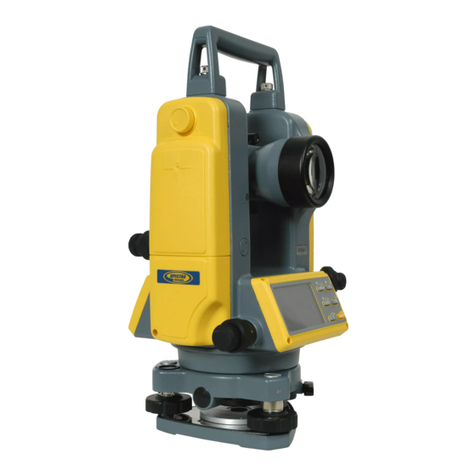
Spectra Precision
Spectra Precision DET-2 User manual
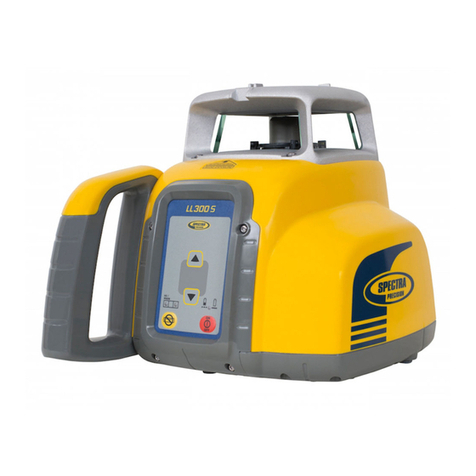
Spectra Precision
Spectra Precision LL300S Installation guide
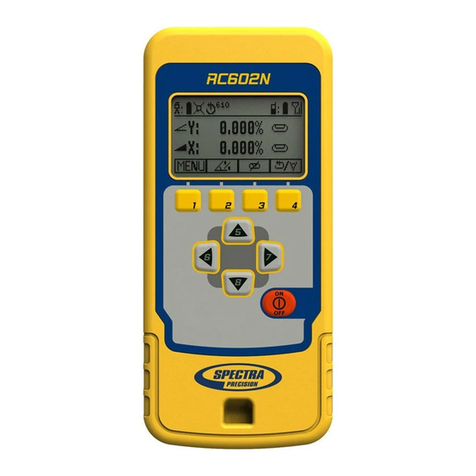
Spectra Precision
Spectra Precision GL6X2N Installation guide
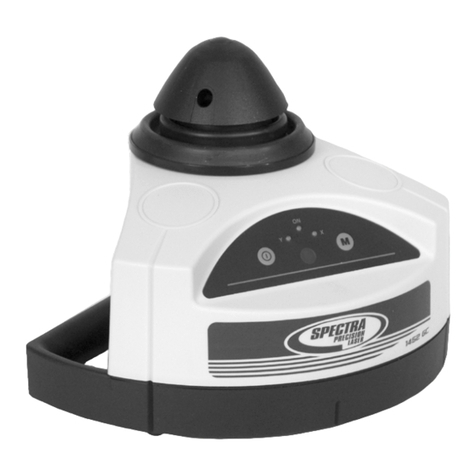
Spectra Precision
Spectra Precision 1452GC User manual
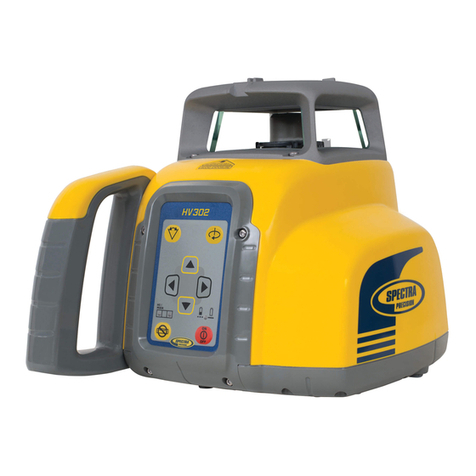
Spectra Precision
Spectra Precision HV302 User manual
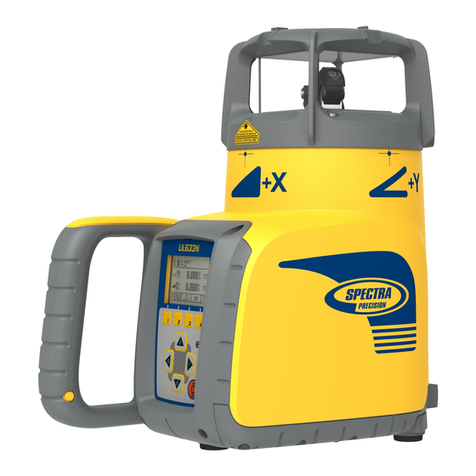
Spectra Precision
Spectra Precision Trimble UL 633N Installation guide

Spectra Precision
Spectra Precision LL300S User manual

Spectra Precision
Spectra Precision HV302 User manual
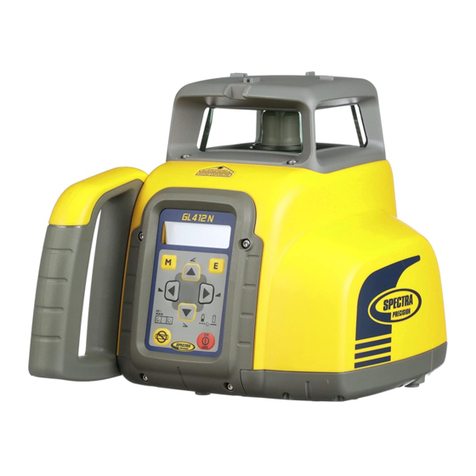
Spectra Precision
Spectra Precision GL412N User manual

Spectra Precision
Spectra Precision LL300S User manual
